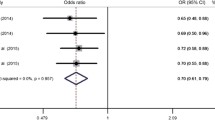Abstract
YWHAE is a gene encoding 14-3-3epsilon, which is highly conserved across species, from bacteria to humans, and binds to phosphoserine/phosphothreonine motifs in a sequence-specific manner. YWHAE has been reported to be associated with schizophrenia in a study based on the Japanese population. Here, we conducted a genetic association analysis between common SNPs in the YWHAE gene and psychiatric diseases including schizophrenia, major depressive disorder and bipolar disorder in Han Chinese samples (1140 schizophrenia cases, 1140 major depressive disorder cases, 1140 bipolar disorder cases and 1140 normal controls). We studied 11 SNPs, seven of which had previously been reported as significant, in YWHAE. No association was found with schizophrenia, major depressive disorder or bipolar disorder. Considering the size of our sample sets (power > 90%), our results suggest that the YWHAE does not play a major role in schizophrenia, major depressive disorder or bipolar disorder in the Han Chinese population.
Similar content being viewed by others
References
Alda M (1997) Bipolar disorder: from families to genes. Can J Psychiatry 42:378–387
Berrettini WH (2000) Susceptibility loci for bipolar disorder: overlap with inherited vulnerability to schizophrenia. Biol Psychiatry 47:245–251
Chen W, Duan S, Zhou J, Sun Y, Zheng Y et al (2004) A case-control study provides evidence of association for a functional polymorphism –197C/G in XBP1 to schizophrenia and suggests a sex-dependent effect. Biochem Biophys Res Commun 319:866–870
Chubb JE, Bradshaw NJ, Soares DC, Porteous DJ, Millar JK (2008) The DISC locus in psychiatric illness. Mol Psychiatry 13:36–64
Frankle WG, Lerma J, Laruelle M (2003) The synaptic hypothesis of schizophrenia. Neuron 39:205–216
Ganguli R, Brar JS, Rabin BS (1994) Immune abnormalities in schizophrenia: evidence for the autoimmune hypothesis. Harv Rev Psychiatry 2:70–83
Grover D, Verma R, Goes FS, Mahon PL, Gershon ES et al (2009) Family-based association of YWHAH in psychotic bipolar disorder. Am J Med Genet B Neuropsychiatr Genet 150B:977–983
Harrison PJ, Owen MJ (2003) Genes for schizophrenia? Recent findings and their pathophysiological implications. Lancet 361:417–419
Ikeda M, Hikita T, Taya S, Uraguchi-Asaki J, Toyo-oka K et al (2008) Identification of YWHAE, a gene encoding 14–3-3epsilon, as a possible susceptibility gene for schizophrenia. Hum Mol Genet 17:3212–3222
Kato T (2007) Molecular genetics of bipolar disorder and depression. Psychiatry Clin Neurosci 61:3–19
Li Z, Zhang Z, He Z, Tang W, Li T, Zeng Z et al (2009) A partition-ligation-combination-subdivision EM algorithm for haplotype inference with multiallelic markers: update of the SHEsis (http://analysis.bio-x.cn). Cell Res 19:519–523
Mignon-Ravix C, Cacciagli P, El-Waly B, Moncla A, Milh M et al (2010) Deletion of YWHAE in a patient with periventricular heterotopias and pronounced corpus callosum hypoplasia. J Med Genet 47:132–136
Morrison DK (2009) The 14–3-3 proteins: integrators of diverse signaling cues that impact cell fate and cancer development. Trends Cell Biol 19:16–23
Mueser KT, McGurk SR (2004) Schizophrenia. Lancet 363:2063–2072
Murray CJ, Lopez AD (1997) Global mortality, disability, and the contribution of risk factors: global burden of disease study. Lancet 349:1436–1442
Nagamani SC, Zhang F, Shchelochkov OA, Bi W, Ou Z et al (2009) Microdeletions including YWHAE in the Miller-Dieker syndrome region on chromosome 17p13.3 result in facial dysmorphisms, growth restriction, and cognitive impairment. J Med Genet 46:825–833
Pantelis C, Yucel M, Wood SJ, Velakoulis D, Sun D et al (2005) Structural brain imaging evidence for multiple pathological processes at different stages of brain development in schizophrenia. Schizophr Bull 31:672–696
Paul LK, Brown WS, Adolphs R, Tyszka JM, Richards LJ et al (2007) Agenesis of the corpus callosum: genetic, developmental and functional aspects of connectivity. Nat Rev Neurosci 8:287–299
Rutter M, Kim-Cohen J, Maughan B (2006) Continuities and discontinuities in psychopathology between childhood and adult life. J Child Psychol Psychiatry 47:276–295
Shenton ME, Dickey CC, Frumin M, McCarley RW (2001) A review of MRI findings in schizophrenia. Schizophr Res 49:1–52
Shi YY, He L (2005) SHEsis, a powerful software platform for analyses of linkage disequilibrium, haplotype construction, and genetic association at polymorphism loci. Cell Res 15:97–98
Squires RF, Saederup E (1991) A review of evidence for GABergic predominance/glutamatergic deficit as a common etiological factor in both schizophrenia and affective psychoses: more support for a continuum hypothesis of “functional” psychosis. Neurochem Res 16:1099–1111
St Clair D, Blackwood D, Muir W, Carothers A, Walker M et al (1990) Association within a family of a balanced autosomal translocation with major mental illness. Lancet 336:13–16
Stephan KE, Baldeweg T, Friston KJ (2006) Synaptic plasticity and dysconnection in schizophrenia. Biol Psychiatry 59:929–939
Woods BT (1998) Is schizophrenia a progressive neurodevelopmental disorder? Toward a unitary pathogenetic mechanism. Am J Psychiatry 155:1661–1670
Yanagi M, Shirakawa O, Kitamura N, Okamura K, Sakurai K et al (2005) Association of 14–3-3 gene haplotype with completed suicide in Japanese. J Hum Genet 50:210–216
Acknowledgments
We are deeply grateful to all patients and healthy controls participating in this study, as well as to the psychiatrists for their help in the recruitment and identification of bipolar disorder patients. This work was supported by the 863 Program (2006AA02A407 and 2009AA022701), the 973 Program (2010CB529600), the Shanghai Changning Health Bureau program (2008406002) and the Shanghai Municipal Health Bureau program (2008095).
Conflict of interest
The authors declare no conflict of interest.
Author information
Authors and Affiliations
Corresponding author
Additional information
Edited by Stacey Cherny.
Electronic supplementary material
Below is the link to the electronic supplementary material.
Rights and permissions
About this article
Cite this article
Liu, J., Zhou, G., Ji, W. et al. No Association of the YWHAE Gene with Schizophrenia, Major Depressive Disorder or Bipolar Disorder in the Han Chinese Population. Behav Genet 41, 557–564 (2011). https://doi.org/10.1007/s10519-010-9426-1
Received:
Accepted:
Published:
Issue Date:
DOI: https://doi.org/10.1007/s10519-010-9426-1




